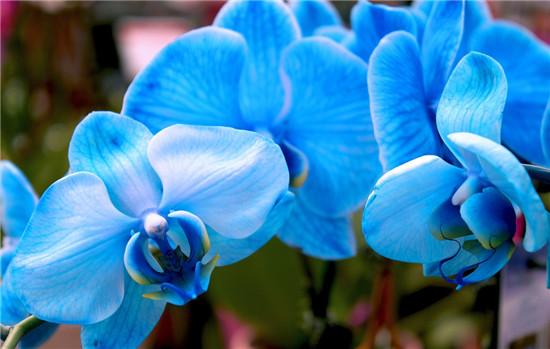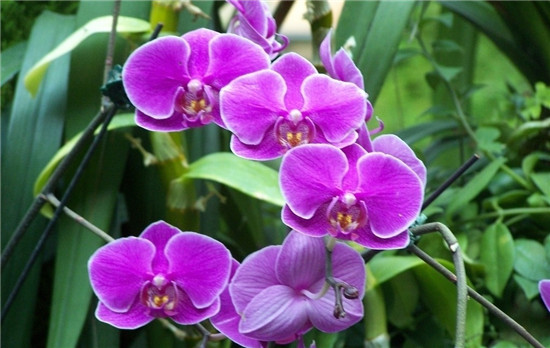[how to raise Phalaenopsis] how to raise Phalaenopsis after flowering
Phalaenopsis is a plant suitable for indoor cultivation, because most of the Phalaenopsis produced in humid Asia, which also determines the growth characteristics of Phalaenopsis, let us go to see how Phalaenopsis bloom Yang bar!

When potted Phalaenopsis, the bottom of the pot is filled with a water-permeable matrix, and 1/3 moss and 2/3 fern roots are used to plant the Phalaenopsis seedlings in the pot, and the seedlings can be fixed in the pot. If completely potted with moss, the moss soaked in water should be squeezed dry, loosely wrapped in the lower part of the root of the orchid seedling, gently pressed, but not too tightly pressed, because the moss absorbs a large amount of water, if pressed too tightly, it will cause root rot.
The best time to change pots is late spring and early summer, just after flowering, when new roots begin to grow. When changing pots, the temperature should not be too low, and a little carelessness in management will cause rotten roots to die.
Potted seedlings should be gradually replaced into a larger pot according to the growth situation, and it is forbidden to plant seedlings directly in large pots. The seedlings need not be removed from the original culture medium to avoid damaging the roots. Just wrap the root around a layer of moss or other potted substrate, plant it in a larger pot, and make the root neck part consistent with the height of the pot edge. The seedlings that grow well can be replaced once every 4-6 months. After pot change, the plants should be placed in shade for two weeks. During this period, no fertilizer should be applied, only water or water should be sprayed properly.
Soil is essential for plant growth. When we choose to plant Phalaenopsis, it is very important to choose soil. Phalaenopsis has higher requirements for soil, such as ventilation, rot resistance, slight acid and water. Generally, we can choose pine needle leaves, peanut shells, bark silk, clay balls and other materials as the substrate for breeding Phalaenopsis. If you can't configure these materials, Xiaobian suggests that you can go directly to the flower market to buy orchid soil dedicated to Phalaenopsis, which is more conducive to the growth of Phalaenopsis.

High humidity is a favorite of Phalaenopsis. Avoid putting Phalaenopsis in a state of water shortage, especially during its growth. Frequent water shortages can cause yellowing of leaves and make it difficult to recover. Usually watering Phalaenopsis can be used to water, watering until the bottom of the pot has water flowing down, avoid pouring too much water.
In the flower forum often see some Phalaenopsis rotten root flower problem, and this may also be due to the lack of a ventilated environment caused. Phalaenopsis delicate, choose ventilated environment will be more conducive to its growth. The sultry environment is not suitable for breeding Phalaenopsis, especially in the southern summer to pay attention to shade Phalaenopsis. Phalaenopsis is epiphytic orchid, sexual preference half shade. Winter temperature is low, to use noon time to ventilate it, but can not let the tuyere blow directly to the orchid plant. Spring and autumn, pay attention to orchids from light. This ensures good lighting and ventilation, and the flowers will be more beautiful when they bloom!

How to raise Phalaenopsis after flowering
1. Do you want to cut arrows after Phalaenopsis blossoms
Phalaenopsis after flowering, flower stems can be cut, but it is best not to cut all (according to the state of the whole plant decision, if the roots and leaves are very healthy and strong, it is recommended to retain a few flower stems, generally more than 2 months later can send out new flower buds), cut off from the first flower or near the first branch, the remaining flower stalk still has buds, raised to a certain time can be re-issued. For orchid plants, do not let it bear fruit, because even if it can bear fruit, it is difficult to reproduce with seeds, and the process of bearing fruit consumes nutrients. Whether fertilization can be observed after flowering plant growth to determine.

2. How to maintain Phalaenopsis after flowering
Butterflies can be a little bit after the flower release fertilizer, to be placed in astigmatism, usually dry and then watering, often spray, pay attention not to wet the sprouts, otherwise easy to rot. In summer, it is best to put it in a cool and ventilated place, and in winter it is best not to be lower than 15 degrees.
The above is what I summarized for you after flowering how to raise the entire content, I hope this article can help you. Please continue to pay attention to us.
Related
- Wuhan Hospital Iron Tree Blooming Result Was Instantly Frightened by the Gardener Master
- Which variety of camellia is the most fragrant and best? Which one do you like best?
- What is the small blue coat, the breeding methods and matters needing attention of the succulent plant
- Dormancy time and maintenance management of succulent plants during dormancy
- Minas succulent how to raise, Minas succulent plant pictures
- What are the varieties of winter succulent plants
- How to raise succulent plants in twelve rolls? let's take a look at some experience of breeding twelve rolls.
- Attention should be paid to water control for succulent plants during dormant period (winter and summer)
- Watering experience of twelve rolls of succulent plants
- Techniques for fertilizing succulent plants. An article will let you know how to fertilize succulent plants.



